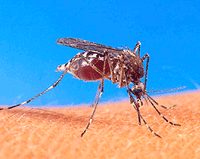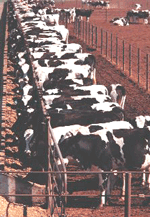
Six Modern Plagues
By Mark Jerome Walters
Island Press, 206 pages, 2003
It’s easy to look at disease outbreaks as acts of God, or fate, or chance. After all, diseases are often so capricious, so stubbornly beyond our full control, that it can seem as if we humans have little to do with them — beyond suffering the consequences, that is. But in many cases, argues journalist and veterinarian Mark Jerome Walters, we have far more influence over disease than we think. In Six Modern Plagues and How We Are Causing Them, he contends that disease outbreaks are often triggered by the damage we’ve done to the environment.
To build his case, Walters looks at the origins of mad cow disease, HIV/AIDS, an antibiotic-resistant strain of salmonella, Lyme disease, hantavirus, and West Nile virus. In each case, he finds evidence that human manipulation of the environment is at least partly responsible for recent outbreaks. The modern epidemic of mad cow disease, for instance, was most likely sparked by the widespread and longstanding practice of “rendering,” or using animal parts in cattle feed. The brisk bush-meat trade in some African markets may have been responsible for passing the HIV virus from apes to humans — and could someday send new, similarly deadly viruses our way as well. There’s also evidence that modern-day outbreaks of hantavirus pulmonary syndrome, an often-fatal respiratory disease carried by rodents in the U.S. Southwest, are linked to global climate change.
Lyme disease, first described in Connecticut in the 1970s and now endemic in parts of the northeastern United States, has almost certainly been helped along by urban and suburban development and its associated habitat fragmentation. Deer, mice, and chipmunks — all bearers of Lyme disease-carrying ticks — have been forced into backyards and parks, increasing the likelihood of infection. “Human activity has put people right at the center of the tick’s life cycle,” a county public-health director from New Jersey tells Walters.

I vant to suck your blood.
Photo: NIEHS/NIH.
Walters’ chapters are brief, giving us only a cursory overview of each “ecodemic,” yet he has a knack for clarifying the complicated behavior of viruses, bacteria, and other disease agents. For example, he untangles the confusing relationships among mad cow disease, sheep-borne scrapie, the chronic wasting disease carried by deer and elk, and the related condition exhibited by humans, clearly explaining the nature of the protein “prions” that carry all four diseases. He also walks us through the murky early days of the West Nile outbreak, when the Centers for Disease Control failed to recognize the link between a rash of bird deaths and the first human victims of the virus.
In several cases, Walters finds dramatic human stories to accompany the science and epidemiology. He describes a Colorado hunter who inadvertently sent meat infected with chronic wasting disease to friends and relatives, and recounts the terrifying experience of Cynthia Hawley, a Vermont dairy farmer who became infected with DT104, a strain of salmonella resistant to most antibiotics. Hawley survived — barely — thanks to a heavy-hitting class of antibiotics called fluoroquinolones.

Lock, livestock, and barrel.
Photo: USDA.
In the salmonella chapter, Walters does a particularly good job of exposing the root environmental causes of disease outbreaks. He chronicles how the livestock and drug industries, despite multiple examples of resistant bacteria, have continued to push for the regular use of antibiotics in large livestock operations. The practice not only allows animals to be raised in close quarters and unsanitary conditions, but also dramatically increases the chances that new, multiple-drug-resistant strains of bacteria will continue to emerge and spread. Federal regulators haven’t put up much of a fight: In 1995, the U.S. Food and Drug Administration even approved the use of fluoroquinolones in poultry. Just two years later, salmonella bacteria in the United States were showing resistance to the drugs that saved Hawley’s life.
Walters also shows how easily and rapidly such drug-resistant bacteria can spread. In the 1970s, he writes, a series of salmonella outbreaks around the world was eventually traced to Peruvian fishmeal. Infected seabirds had defecated on the fish, which had been drying on boat decks; the fishmeal was fed to poultry, the poultry was fed to people, and the people became sick with salmonella.
Walters writes, “It is only a matter of time, [the CDC’s Frederick] Angulo and others worry, before our brushes with drug-resistant salmonella will lead to a head-on collision with a full-force epidemic capable of killing thousands of people. ‘It may never happen,’ he concedes. ‘But why would we want to invite such a catastrophe?'”
The effects of environmental damage on disease outbreaks aren’t always so direct and well-established. In his chapter on hantavirus, Walters discusses the possibility that climate change — in this case, increased winter and summer rains in the Southwest — has led to an explosion in mouse populations and an associated increase in human infections. Walters supplies some fascinating testimony from Navajo elders, who recognized the disease and its link to heavy rainfall decades before public-health authorities. Since the first widely publicized hantavirus outbreak in 1993, ecological data has corroborated the elders’ observations.
Though Walters puts together a sturdy case for the ecological roots of modern plagues — showing, as his title promises, “how we are causing them” — he gives us very little advice on how we might stop them. The book ends with an exhortation to protect and restore “the ecological wholeness upon which our health often depends.” That call to arms would have been stronger if it had been bolstered by examples of the many individuals, organizations, and government agencies that are beginning to study and publicize the ties between large-scale deforestation and human disease outbreaks. (The Rainforest Action Network, World Resources Institute, and World Health Organization have all dedicated time and energy to the cause.)
Despite its omissions, Six Modern Plagues makes an important and potentially life-saving point — one that’s becoming more and more difficult to ignore. “Preservation of natural ecosystems, along with greater social equity, research, good surveillance, and benefits of modern medicine, can improve the health of not only people but many species,” Walter writes. “Human health does not belong to us alone. Nor, unfortunately, do the plagues we are all now experiencing.”

